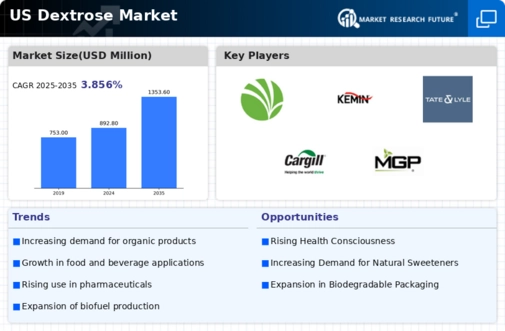Rising Demand in Pharmaceutical Sector
The pharmaceutical sector's increasing reliance on dextrose for various applications is emerging as a key driver for the dextrose market. Dextrose is commonly used in intravenous (IV) solutions, as it provides essential energy and hydration to patients. The growing prevalence of chronic diseases and the aging population in the US are likely to boost the demand for dextrose in medical applications. In 2025, the pharmaceutical segment is anticipated to represent approximately 25% of the total dextrose market, reflecting its importance in healthcare. The dextrose market is thus positioned to benefit from this trend, as healthcare providers increasingly utilize dextrose in treatment protocols and patient care.
Health Consciousness and Dietary Trends
The increasing awareness of health and wellness among consumers appears to be a pivotal driver for the dextrose market. As individuals seek healthier alternatives to refined sugars, the demand for dextrose, which is perceived as a natural sweetener, is likely to rise. This trend is particularly evident in the food and beverage sector, where manufacturers are reformulating products to reduce sugar content while maintaining sweetness. In 2025, the market for natural sweeteners, including dextrose, is projected to grow at a CAGR of approximately 6.5%, indicating a robust shift towards healthier dietary choices. The dextrose market is thus positioned to benefit from this health-centric consumer behavior, as more products incorporate dextrose as a preferred ingredient.
Technological Advancements in Production
Technological innovations in the production of dextrose are likely to enhance efficiency and reduce costs, thereby driving growth in the dextrose market. Advances in enzymatic processes and fermentation technology have improved the yield and purity of dextrose, making it a more attractive option for manufacturers. In 2025, the cost of production is expected to decrease by approximately 10% due to these advancements, which could lead to lower prices for consumers. This reduction in production costs may encourage more companies to incorporate dextrose into their products, further expanding the dextrose market. As production methods become more sustainable, the appeal of dextrose as an ingredient is likely to increase, aligning with consumer preferences for environmentally friendly products.
Regulatory Support for Natural Ingredients
Regulatory frameworks that favor the use of natural ingredients are likely to bolster the dextrose market. As consumers become more discerning about food labels, regulatory bodies are promoting transparency and the use of natural sweeteners. This shift is encouraging manufacturers to replace artificial sweeteners with dextrose, which is perceived as a safer and more natural alternative. In 2025, it is expected that regulatory support will lead to a 15% increase in the adoption of dextrose in food products. The dextrose market stands to gain from this regulatory environment, as companies align their product offerings with consumer preferences for clean labels and natural ingredients.
Expanding Applications in Food and Beverage
The versatility of dextrose in various applications within the food and beverage industry is a significant driver for the dextrose market. Dextrose is utilized not only as a sweetener but also as a preservative, bulking agent, and fermentation substrate. The growing trend of product innovation in the food sector, including the development of low-calorie and functional foods, is likely to increase the demand for dextrose. In 2025, the food and beverage segment is projected to account for over 60% of the total dextrose consumption in the US, highlighting its critical role in product formulation. The dextrose market is thus expected to thrive as manufacturers continue to explore new applications and formulations that leverage the unique properties of dextrose.
















Leave a Comment